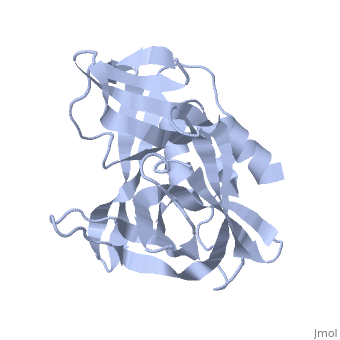2j92
From Proteopedia
3C PROTEASE FROM TYPE A10(61) FOOT-AND-MOUTH DISEASE VIRUS - Crystal packing mutant (K51Q)
Structural highlights
FunctionPOLG_FMDV1 The leader protease autocatalytically cleaves itself from the polyprotein at the L/VP0 junction. It cleaves the host translation initiation factors EIF4G1 and EIF4G3, in order to shut down the capped cellular mRNA transcription (By similarity). Capsid proteins VP1, VP2, VP3 and VP4 form a closed capsid enclosing the viral positive strand RNA genome. VP4 lies on the inner surface of the protein shell formed by VP1, VP2 and VP3. All the three latter proteins contain a beta-sheet structure called beta-barrel jelly roll. Together they form an icosahedral capsid (T=3) composed of 60 copies of each VP1, VP2, and VP3, with a diameter of approximately 300 Angstroms. VP1 is situated at the 12 fivefold axes, whereas VP2 and VP3 are located at the quasi-sixfold axes. The capsid interacts with host heparan sulfate and various integrins (alphavbeta1, alphavbeta3, alpha5beta1, alphavbeta6, alphavbeta8) to provide virion attachment to target Attachment via host integrins induces virion internalization predominantly through clathrin-mediated endocytosis (By similarity). Protein VP0: VP0 precursor is a component of immature procapsids (By similarity). Protein 2B: Affects membrane integrity and cause an increase in membrane permeability (By similarity). Protein 2C: Associates with and induces structural rearrangements of intracellular membranes. It displays RNA-binding, nucleotide binding and NTPase activities (By similarity). Protein 3A, via its hydrophobic domain, serves as membrane anchor (By similarity). Protein 3B-1, 3B-2 and 3B-3 are covalently linked to the 5'-end of both the positive-strand and negative-strand genomic RNAs. They acts as a genome-linked replication primer (By similarity). Protease 3C: cysteine protease that generates mature viral proteins from the precursor polyprotein. In addition to its proteolytic activity, it binds to viral RNA, and thus influences viral genome replication. RNA and substrate bind cooperatively to the protease (By similarity). RNA-directed RNA polymerase 3D-POL replicates genomic and antigenomic RNA by recognizing replications specific signals (By similarity). Evolutionary ConservationCheck, as determined by ConSurfDB. You may read the explanation of the method and the full data available from ConSurf. Publication Abstract from PubMedThe 3C protease (3C(pro)) from foot-and-mouth disease virus (FMDV), the causative agent of a widespread and economically devastating disease of domestic livestock, is a potential target for antiviral drug design. We have determined the structure of a new crystal form of FMDV 3C(pro), a chymotrypsin-like cysteine protease, which reveals features that are important for catalytic activity. In particular, we show that a surface loop which was disordered in previous structures adopts a beta-ribbon structure that is conformationally similar to equivalent regions on other picornaviral 3C proteases and some serine proteases. This beta-ribbon folds over the peptide binding cleft and clearly contributes to substrate recognition. Replacement of Cys142 at the tip of the beta-ribbon with different amino acids has a significant impact on enzyme activity and shows that higher activity is obtained with more hydrophobic side chains. Comparison of the structure of FMDV 3C(pro) with homologous enzyme-peptide complexes suggests that this correlation arises because the side chain of Cys142 contacts the hydrophobic portions of the P2 and P4 residues in the peptide substrate. Collectively, these findings provide compelling evidence for the role of the beta-ribbon in catalytic activity and provide valuable insights for the design of FMDV 3C(pro) inhibitors. Structural and mutagenic analysis of foot-and-mouth disease virus 3C protease reveals the role of the beta-ribbon in proteolysis.,Sweeney TR, Roque-Rosell N, Birtley JR, Leatherbarrow RJ, Curry S J Virol. 2007 Jan;81(1):115-24. Epub 2006 Oct 25. PMID:17065215[1] From MEDLINE®/PubMed®, a database of the U.S. National Library of Medicine. See AlsoReferences
| ||||||||||||||||||


